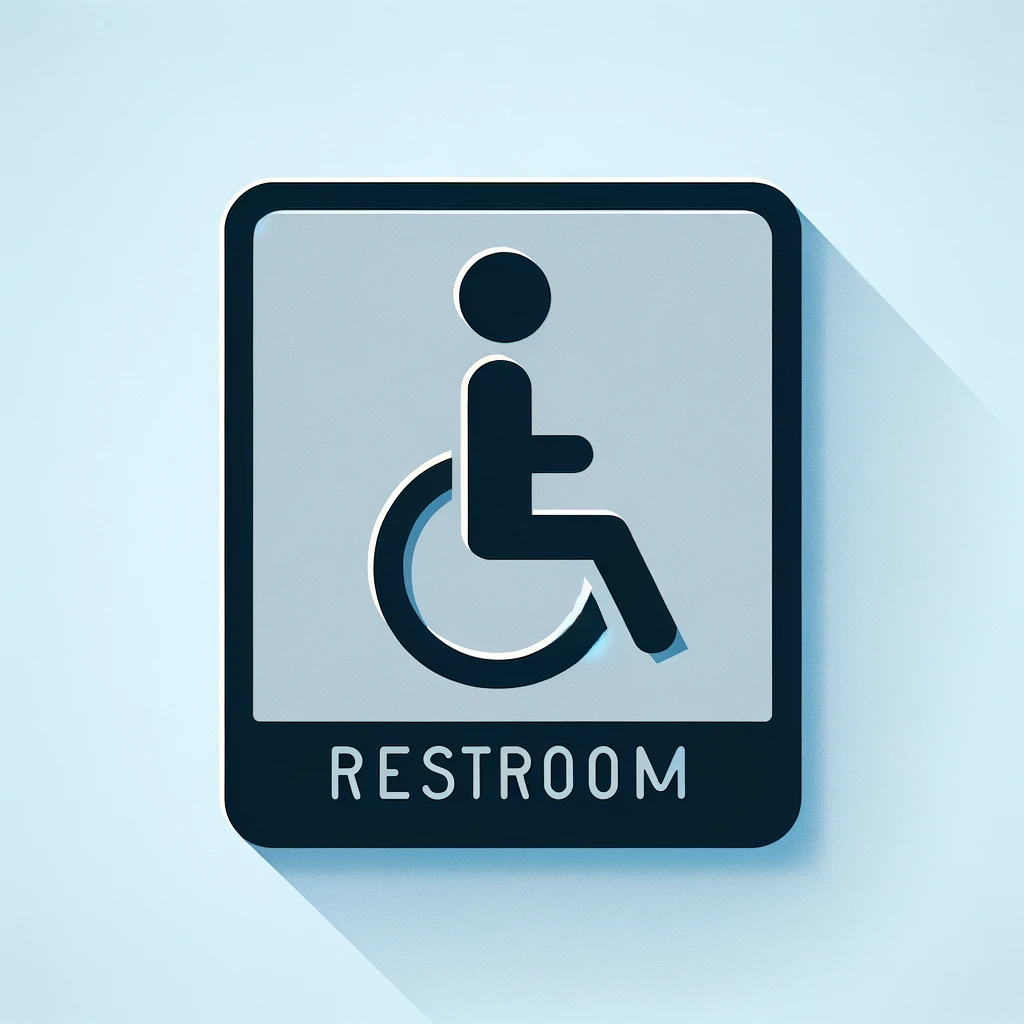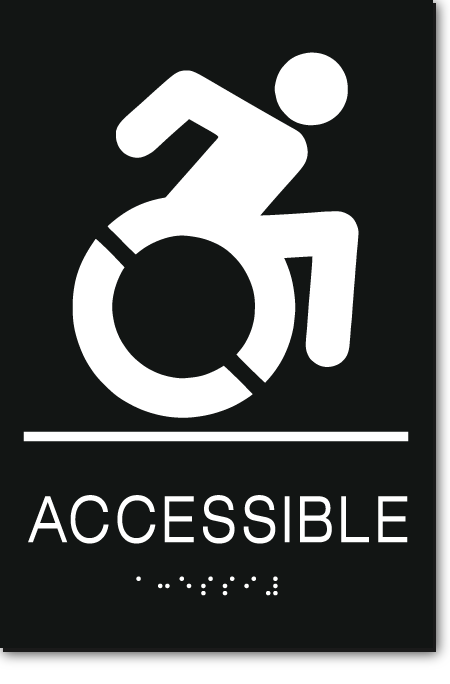The Advantages of Using High-Quality ADA Signs in Your Business
Exploring the Key Features of ADA Indications for Enhanced Availability
In the world of access, ADA indications function as silent yet effective allies, making certain that rooms are accessible and comprehensive for people with impairments. By integrating Braille and responsive components, these indicators break barriers for the visually damaged, while high-contrast color design and clear fonts accommodate diverse visual demands. In addition, their calculated placement is not arbitrary yet instead a computed initiative to help with seamless navigating. Beyond these features lies a deeper narrative regarding the advancement of inclusivity and the continuous commitment to producing equitable areas. What much more could these signs signify in our search of universal accessibility?
Relevance of ADA Conformity
Making certain compliance with the Americans with Disabilities Act (ADA) is critical for cultivating inclusivity and equal accessibility in public rooms and work environments. The ADA, passed in 1990, mandates that all public centers, employers, and transport solutions suit people with handicaps, guaranteeing they delight in the exact same civil liberties and chances as others. Compliance with ADA criteria not just meets lawful obligations but additionally improves a company's credibility by demonstrating its dedication to variety and inclusivity.
One of the key facets of ADA compliance is the application of accessible signage. ADA indications are created to make sure that people with impairments can quickly browse via spaces and buildings. These signs must abide by specific guidelines pertaining to dimension, font style, shade comparison, and placement to assure presence and readability for all. Properly executed ADA signs helps get rid of obstacles that people with impairments typically encounter, thus promoting their self-reliance and confidence (ADA Signs).
Moreover, sticking to ADA guidelines can minimize the risk of lawful consequences and prospective penalties. Organizations that fall short to abide with ADA standards may face charges or suits, which can be both harmful and economically troublesome to their public picture. Hence, ADA conformity is important to fostering a fair setting for everyone.
Braille and Tactile Elements
The incorporation of Braille and responsive elements into ADA signs embodies the principles of ease of access and inclusivity. These functions are essential for people that are blind or visually damaged, allowing them to navigate public areas with higher independence and self-confidence. Braille, a responsive writing system, is important in providing written info in a layout that can be easily perceived with touch. It is usually positioned beneath the corresponding message on signage to make sure that people can access the information without visual support.
Tactile elements expand past Braille and consist of increased personalities and icons. These elements are created to be noticeable by touch, permitting people to recognize room numbers, washrooms, leaves, and various other vital areas. The ADA establishes specific guidelines concerning the dimension, spacing, and placement of these responsive components to enhance readability and guarantee consistency across different settings.

High-Contrast Color Design
High-contrast color schemes play a crucial role in enhancing the exposure and readability of ADA signage for people with aesthetic disabilities. These plans are essential as they take full advantage of the distinction in light reflectance in between text and background, ensuring that indications are quickly discernible, even from a distance. The Americans with Disabilities Act (ADA) mandates making use of certain shade contrasts to accommodate those with restricted vision, making it a critical facet of conformity.
The efficiency of high-contrast shades exists in their capability to stand apart in various lighting problems, including dimly lit environments and locations with glare. Commonly, dark text on a light background or light message on a dark history is used to attain optimal contrast. Black text on a white or yellow background supplies a plain aesthetic difference that assists in fast recognition and understanding.

Legible Fonts and Text Dimension
When taking into consideration the design of ADA signs, the option of readable fonts and ideal text dimension can not be overemphasized. These aspects are important for making certain that indicators come to people with aesthetic impairments. The Americans with Disabilities Act (ADA) mandates that font styles need to be sans-serif and not italic, oblique, script, extremely attractive, or of unusual kind. These demands assist guarantee that the message is quickly readable from a distance and that the personalities are appreciable to varied target markets.
The size of the message additionally plays an essential duty in ease of access. According to ADA guidelines, the minimum message height must be 5/8 inch, and it ought to increase proportionally with checking out distance. This is especially essential in public areas where signage requirements to be reviewed promptly and properly. Uniformity in text size adds to a cohesive aesthetic experience, helping individuals in navigating atmospheres efficiently.
In addition, spacing between lines and letters is important to readability. Ample spacing stops characters from showing up crowded, improving readability. By adhering to these requirements, developers can significantly enhance ease of access, making certain that signs offers its designated purpose for all individuals, no matter of their aesthetic capabilities.
Reliable Positioning Approaches
Strategic positioning of ADA signs is crucial for making best use of availability and making sure conformity with lawful requirements. Effectively positioned indications assist people with impairments effectively, promoting navigating in public rooms. Secret considerations include elevation, visibility, and closeness. ADA guidelines specify that indications should be placed at an elevation in between 48 to 60 inches from the ground to guarantee they are within the line of sight for both standing and seated people. This read more standard elevation range is crucial for inclusivity, making it possible for wheelchair customers and people of varying elevations to gain access to information effortlessly.
In addition, indications have to be put beside the lock side of doors to permit easy identification prior to entrance. This positioning aids people find areas and spaces without blockage. In cases where there is no door, indicators need to be positioned on the nearest surrounding wall surface. Uniformity in indication placement throughout a facility boosts predictability, minimizing complication and boosting overall customer experience.

Verdict
ADA signs play an essential function in advertising access by integrating attributes that attend to the demands of people with specials needs. These aspects collectively cultivate a comprehensive setting, underscoring the importance of ADA conformity in guaranteeing equivalent accessibility for all.
In the world of access, ADA indications offer as hop over to these guys silent yet effective allies, making certain that spaces are comprehensive and accessible for people with handicaps. The ADA, established in 1990, mandates that all public centers, companies, and transport services accommodate individuals with disabilities, guaranteeing they appreciate the exact same legal rights and possibilities as others. ADA Signs. ADA indications are made to make certain that individuals with impairments can conveniently navigate through spaces and buildings. ADA standards specify that signs need to be placed at a height in between 48 to 60 inches from the ground to guarantee they are within the line of sight for both standing and that site seated individuals.ADA indications play an important function in advertising availability by incorporating attributes that address the needs of people with disabilities